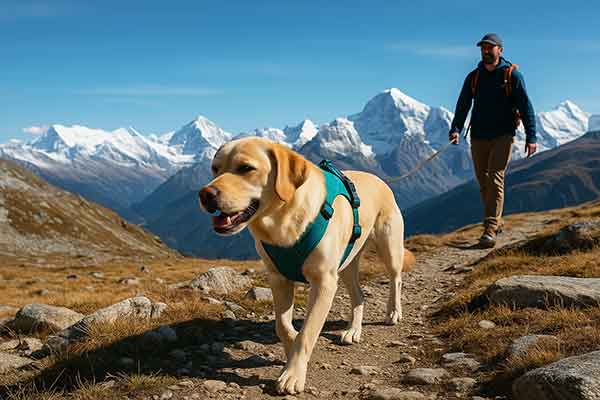Can Dogs Get Altitude Sickness? Signs, Prevention & Travel Tips
If you’re an outdoor enthusiast planning a trip to the mountains, you may wonder, “Can dogs get altitude sickness?” The short answer is yes—dogs can suffer from altitude sickness, just like humans. Whether you’re hiking in the Rockies, driving through a high-altitude pass, or relocating to a new home at elevation, it’s important to understand how altitude can affect your canine companion.
In this comprehensive guide, we’ll cover the causes and symptoms of altitude sickness in dogs, how to prevent it, and what to do if your dog shows signs of discomfort at higher elevations.
Table of Contents
- What Is Altitude Sickness?
- Can Dogs Get Altitude Sickness?
- Symptoms of Altitude Sickness in Dogs
- Risk Factors: Which Dogs Are Most Vulnerable?
- How to Prevent Altitude Sickness in Dogs
- What to Do If Your Dog Gets Sick at Altitude
- Can Altitude Cause Long-Term Health Issues in Dogs?
- FAQ
What Is Altitude Sickness?
Altitude sickness, also known as acute mountain sickness (AMS), occurs when the body cannot get enough oxygen from the air at high elevations. As altitude increases, air pressure and oxygen levels decrease, which can lead to various symptoms in both humans and animals.
Common human symptoms include:
- Headache
- Nausea
- Dizziness
- Shortness of breath
- Fatigue
Dogs can experience many of the same symptoms, though they often display them differently.
Can Dogs Get Altitude Sickness?
Yes, dogs can get altitude sickness. While not all dogs are affected the same way, any dog suddenly exposed to high elevation—typically above 8,000 feet (2,438 meters)—may experience symptoms due to reduced oxygen availability.
Dogs rely on similar physiological mechanisms as humans to adapt to lower oxygen levels. However, since they cannot communicate discomfort as clearly, pet parents must monitor their behavior closely during altitude changes.

Symptoms of Altitude Sickness in Dogs
The signs of altitude sickness in dogs can be subtle at first, but they may worsen if your dog continues to exert energy or climb higher. Common symptoms include:
- Labored breathing or panting
- Excessive drooling
- Vomiting or nausea
- Lethargy or weakness
- Loss of appetite
- Uncoordinated movements
- Increased heart rate
- Disorientation or confusion
- Pale gums or bluish tongue (sign of oxygen deprivation)
Severe symptoms: If your dog collapses, has seizures, or shows signs of pulmonary edema (fluid in the lungs), seek emergency veterinary care immediately.
Risk Factors: Which Dogs Are Most Vulnerable?
Not all dogs react to altitude the same way. Certain factors increase the risk:
1. Brachycephalic Breeds
Dogs with flat faces (e.g., Bulldogs, Pugs, Shih Tzus) have restricted airways and already struggle with breathing. Altitude exacerbates this condition.
2. Puppies and Seniors
Younger and older dogs may have weaker respiratory and circulatory systems, making adaptation more difficult.
3. Dogs With Heart or Lung Conditions
Canines with pre-existing health issues are less tolerant of oxygen deprivation and should avoid strenuous activity at high altitudes.
4. Unfit or Overweight Dogs
Poor physical condition can hinder oxygen uptake and increase the risk of altitude-related fatigue or distress.
How to Prevent Altitude Sickness in Dogs
1. Ascend Gradually
Give your dog time to acclimate. If possible, increase elevation over several days rather than in one long trip.
2. Hydration Is Critical
Make sure your dog has constant access to fresh water. Dehydration worsens altitude symptoms and reduces blood oxygen efficiency.
3. Limit Activity
Keep exercise light during the first 48 hours. Avoid hikes, runs, or rough play until your dog shows no signs of distress.
4. Monitor Closely
Watch for any unusual behavior, especially panting, fatigue, or loss of coordination. Don’t ignore even mild signs of altitude stress.
5. Keep Warm
High altitudes are often cold. If your dog gets chilled, it may stress the body further. Use a jacket or blanket, especially for short-haired breeds.
6. Avoid Overfeeding
A full stomach increases the demand for oxygen during digestion. Offer small, light meals during the acclimation period.
7. Talk to Your Vet
If you’re planning a high-altitude trip, ask your vet about travel readiness, especially if your dog has health concerns.
What to Do If Your Dog Gets Sick at Altitude
If your dog shows signs of altitude sickness:
- Descend immediately—even a few hundred feet can help improve oxygen intake
- Provide water and encourage rest in a shaded or warm area
- Reduce physical exertion—carry your dog if necessary
- Contact a vet if symptoms persist or worsen
Don’t force your dog to continue hiking or playing through symptoms. Prompt action is the best defense against serious health issues.
Can Altitude Cause Long-Term Health Issues in Dogs?
In most cases, symptoms of altitude sickness are temporary and resolve after descending or acclimating. However, repeated or prolonged exposure can have more serious effects:
- Pulmonary edema – fluid buildup in the lungs due to extreme oxygen deprivation
- Hypoxia-related organ damage – rare but possible with sustained high-altitude exposure
If your dog will be living at altitude long-term (e.g., relocating to Colorado), allow several weeks of slow acclimation and monitor closely for chronic changes in appetite, stamina, or breathing.
FAQ
How high is too high for dogs?
Dogs can start showing symptoms of altitude sickness at around 8,000 feet (2,438 meters). Risks increase significantly beyond 10,000 feet (3,048 meters), especially for sensitive breeds or dogs with health issues.
Can I give my dog oxygen at altitude?
Portable oxygen masks are available for dogs and may be used in extreme cases. Always consult your vet before using oxygen therapy, and never rely on it as a first-line solution.
Do dogs get used to high altitude?
Yes. With proper acclimation (over days or weeks), many dogs adjust well to high altitudes. Monitor closely during the initial adjustment period.
Can puppies travel to high elevation?
Puppies are more vulnerable and should be introduced to altitude slowly. Limit physical activity and keep a close eye on hydration and behavior.
What if my dog vomits at altitude?
Vomiting is a common sign of altitude sickness. Offer water, limit activity, and descend if possible. If vomiting continues for more than 24 hours, see a vet immediately.
Conclusion
So, can dogs get altitude sickness? Absolutely. Just like their human companions, dogs may struggle to adapt to higher elevations if not given time and care. Whether you’re heading to the mountains for a vacation or moving to a high-altitude region, understanding the signs of altitude sickness in dogs is crucial to keeping your furry friend safe and comfortable.
With proper preparation, hydration, and observation, most dogs can enjoy high-altitude adventures just as much as you do. When in doubt, consult your veterinarian to ensure your pup is altitude-ready.


